What We Let Go Of
 I love what Winnie Nazarko said in the Dharma Seed talk we listened to on Monday night. The talk was all about “letting go,” which we hear a lot about. What I love is her clarity.
I love what Winnie Nazarko said in the Dharma Seed talk we listened to on Monday night. The talk was all about “letting go,” which we hear a lot about. What I love is her clarity.
“What we let go of…..is suffering.”
So it’s not that we need to let go of what we want. It’s that we need to let go of the suffering caused by wanting what we want.
It’s fine to want something. But if that something is not possible…like, for example, you want the information you’ve been given about the Burmese visa application process to be accurate, reliable, and readily available…then continuing to want it, when it’s clear that that’s simply not the way it is…just adds suffering to what is already a difficult situation.
So….keep doing what you can to comply with the visa application requirements, keep checking to see if the first application has been approved, have a back-up plan in case it doesn’t look like it’s going to happen before the plane takes off….and let go of the continual thought that it shouldn’t be like that.
Whether it should or shouldn’t is beside the point.
It is what it is.
There’s a lot less suffering when you deal with it like that.
In a State of Activity
 One of my dear Dharma Buddies sent me this quote, which I offer as a reminder for this Holiday Season:
One of my dear Dharma Buddies sent me this quote, which I offer as a reminder for this Holiday Season:
Meditation in a state of activity is even more profound than in a state of quietude.
(Thanks, Christy!)
Advanced Practice
 The saga of the Burmese visa application process continues. At first we were told that if we wanted to stay on at one of the monasteries after our tour with Tempel, we would need to get a Meditation visa. This would allow us to stay in the country for more than 28 days…which is the maximum stay for a Tourist visa. We were told that it would actually be quicker to get a Meditation visa, although we’d first have to get a letter from the monastery where we planned to stay. Which we did.
The saga of the Burmese visa application process continues. At first we were told that if we wanted to stay on at one of the monasteries after our tour with Tempel, we would need to get a Meditation visa. This would allow us to stay in the country for more than 28 days…which is the maximum stay for a Tourist visa. We were told that it would actually be quicker to get a Meditation visa, although we’d first have to get a letter from the monastery where we planned to stay. Which we did.
And since both types of visas are only good for 3 months after issue, we should wait to send the application in until late in October. So we did.
But it turns out that things have changed. After we sent in the applications, the embassy said that it takes 3 months to get a Meditation visa. Which is a problem since I sent in my application on Oct 30 and I depart on January 7.
Leahe and I have already planned to arrive and depart together…and to stay at U Tejaniya’s monastery together after our time with Tempel…and we thought we’d have to re-apply for a Tourist visa, because apparently now Tourist visas only take about 10 days to get. But we had already made our plane reservations to arrive in Yangon on January 8 and depart on February 5, which we counted as 29 days. The embassy said absolutely, positively, NO EXTENSIONS.
Although Tempel thought maybe that’s not the case.
But we didn’t want to take any chances. So we were about to change our plane tickets, when we discovered that Jan 8 to Feb 5 counts as 28 days. At least according to the embassy.
So we were set. But then we realized that we can’t stay at the monastery with just a Tourist visa.
Now what to do?
Leahe called the embassy this morning and they said that the Ministry of Religious Affairs will approve applications one month before departure. So it’s still possible that our applications for Meditation visas will come through.
So we’re waiting until after Dec 8….the embassy suggests Dec 16….to check to see whether or not they come through. If they do, we’re good. If not, we have to quickly apply for a Tourist visa….and then figure out where we’re going to stay from the time Tempel takes his leave of us on Jan 23 until we fly out of Yangon on Feb 5.
Hmmm.
Sounds like Advanced Practice.
When the Mind Gets Quiet
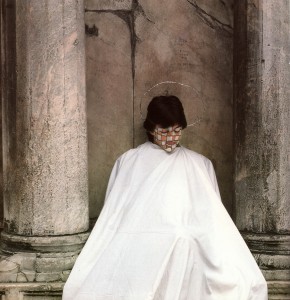 The depth of Buddhist teachings explores the mysteriousness of human life and incarnation as a human being, having consciousness and so forth….
The depth of Buddhist teachings explores the mysteriousness of human life and incarnation as a human being, having consciousness and so forth….
When the mind gets quiet and silent, then that sense of mystery starts to open. And the questions about what really matters and what are the ways of operating in this human life that bring joy, that bring freedom, that bring benefit, are what start to arise.
— Jack Kornfield
(image from Carnaval de Venise, by Fulvio Roiter)
I’m Thankful I’m Alive
In honor of Thanksgiving, I offer this excerpt from an article by Wes Nisker, reprinted in the latest issue of Spirit Rock News….for which I am also thankful:
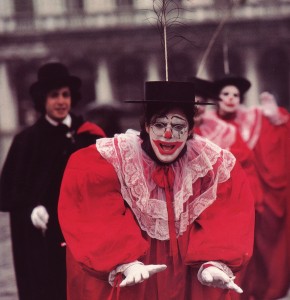 Strange to say so, but one of the best things I learned in meditation is that I’m alive. I had rarely noticed it, but through increasing awareness of body and breath I began to pay attention to this mysterious condition. Now my identity includes the fact that I am one of the living! I am a live one!
Strange to say so, but one of the best things I learned in meditation is that I’m alive. I had rarely noticed it, but through increasing awareness of body and breath I began to pay attention to this mysterious condition. Now my identity includes the fact that I am one of the living! I am a live one!
You too are a member of the sangha of the living. Welcome. Glad you could make it. Life on earth is now appearing as (your name here).
The path of meditation reminds us that we are alive by leading us from our heads into our bodies. We come down from the story of our life to the fact of our life.
My teacher S.N. Goenka told me to sweep my body with awareness, and slowly but surely I became familiar with my nose and my toes, and what the poet Mary Oliver calls the world of “lime and appetite, the oceanic fluids.” This bag of bones and seawater came alive and started to take over my ego as the foundation of my identity. You might say, I was “born again,” as an animal. I had to join a grand and venerable sangha.
When I witness myself in the story of evolution, I feel a surge of compassion for the struggles of all my life. Let’s face it, the basic rules on this planet are nasty and brutish. But the phrase, “May all being be happy” has a deeper ring to it when I regard myself in the same world as those who dress in feathers, fur, scales, leaves and bark.
Now when I sit in mediation I can feel my aliveness, my mammalian condition, my species self. I also sense my practice as part of a group effort by human beings to awaken to a new kind of freedom and sanity. In the light of that big perspective, I thank you for being on my team, part of this exciting project, helping us all to realize our precious, collective, human potential.”
***
(image from Carnaval de Venise, by Fulvio Roiter)
More Questions, More Answers
 If you listened to Joseph Goldstein answer questions from yogis during the second half of the 3-month retreat at IMS (which I posted about here) and you were hoping for more — you’re in luck! There’s a new Q&A session with Joseph posted on Dharma Seed, in which he talks about all kinds of wild and wonderful things including: creativity, the hallucination of wrong view, trauma, stream entry, and much more. Click here to listen.
If you listened to Joseph Goldstein answer questions from yogis during the second half of the 3-month retreat at IMS (which I posted about here) and you were hoping for more — you’re in luck! There’s a new Q&A session with Joseph posted on Dharma Seed, in which he talks about all kinds of wild and wonderful things including: creativity, the hallucination of wrong view, trauma, stream entry, and much more. Click here to listen.
What I’m Reading Now
 I decided to take my name off the wait list for the retreat for experienced students coming up at IMS next March/April, in which both Joseph Goldstein and Bhikkhu Analyao will be teaching on the Satipatthana Sutta. (I was number 169 and a full house is less than 100 yogis.)
I decided to take my name off the wait list for the retreat for experienced students coming up at IMS next March/April, in which both Joseph Goldstein and Bhikkhu Analyao will be teaching on the Satipatthana Sutta. (I was number 169 and a full house is less than 100 yogis.)
But I am consoling myself with Joseph’s new book: Mindfulness, A Practical Guide to Awakening, which is based on a series of 47 talks he gave on this same, key teaching.
For an overview of the book, here’s the intro on the jacket cover:
“The mind contains the seeds of its own awakening–seeds that we can cultivate to bring forth the fruits of a life lived consciously. With Mindfulness, Joseph Goldstein shares the wisdom of his four decades of teaching and practice in a book that will serve as a lifelong companion for anyone committed to mindful living and the realization of inner freedom.”
For an idea of how clear and comprehensive it is, here’s the table of contents:
The Four Qualities of Mind
Ardency: The Long-Enduring Mind
Clearly Knowing: Cultivating Clear Comprehension
Mindfulness: The Gateway to Wisdom
Concentration: The Collected Nature of Mind
The Satipatthana Refrain
Contemplating the Four Foundations
Bare Knowing and Continuity of Mindfulness
Mindfulness of the Body
Mindfulness of Breathing
Mindfulness of Postures
Mindfulness of Activities
Mindfulness of Physical Characteristics
Mindfulness of Feelings
Liberation through Feelings
Worldly and Unworldly Feelings
The Wholesome and Unwholesome Roots of Mind
The Refrain: On Feelings and the Mind
Mindfulness of Dhammas–The Five Hindrances
Desire
Aversion
Sloth and Torpor
Restlessness and Worry
Doubt
Mindfulness of Dhammas–The Five Aggregates of Clinging
Material Elements, Feelings, and Perceptions
Formations and Consciousness
Contemplating the Five Aggregates
Mindfulness of Dhammas–The Six Sense Spheres
How We Experience the World
The Wheel of Samsara
Mindfulness of Dhammas–The Seven Factors of Awakening
Mindfulness
Investigation of Dhammas
Energy
Rapture
Calm
Concentration
Equanimity
Mindfulness of Dhammas–The Four Noble Truths
The First Noble Truth: Dukkha
The Second Noble Truth: The Cause of Dukkha
The Third Noble Truth: The Cessation of Dukkha
The Fourth Noble Truth: The Way Leading to the Cessation of Dukkha
Mindfulness of Dhammas–The Noble Eightfold Path: Wisdom Factors
Right View: Worldly Ease
Right View: Liberation
Right Thought: Renunciation
Right Thought: Lovingkindness
Right Thought: Compassion
Mindfulness of Dhammas–The Noble Eightfold Path: Morality Factors
Right Speech
Right Action and Right Livelihood
Mindfulness of Dhammas–The Noble Eightfold Path: Concentration Factors
Right Effort, Right Mindfulness, Right Concentration
The Realization of Nibbana
***
That ought to keep me busy!
How We Make the World
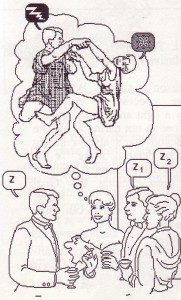 We are what we think.
We are what we think.
All that we are arises with our thoughts.
With our thoughts we make the world.
Speak or act with an impure mind
And trouble will follow you
As the wheel follows the ox that draws the cart.
We are what we think.
All that we are arises with our thoughts.
With our thoughts we make the world.
Speak or act with a pure mind
And happiness will follow you
As your shadow, unshakable.
How can a troubled mind
Understand the way?
Your worst enemy cannot harm you
As much as your own thoughts, unguarded.
But once mastered,
No one can help you as much,
Not even your father or your mother.
***
— text from the Dhammapada, translated by Thomas Byron
— image from Zen & the Art of the Macintosh: Discoveries on the Path to Computer Enlightenment, by Michael Green….another of the treasures I discovered while cleaning out my bookcase!
More Treasure
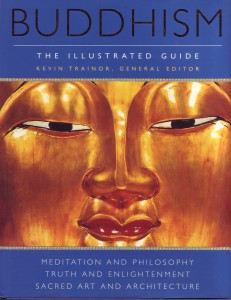 While cleaning out one of my bookcases (see yesterday’s post) I also found — somewhere among the German and Italian dictionaries, catalogues of exhibits at the Tate Modern, guidebooks to hawker food in Singapore, and a 1981 Rand McNally Road Atlas of the US — this gorgeous book on Buddhist art!
While cleaning out one of my bookcases (see yesterday’s post) I also found — somewhere among the German and Italian dictionaries, catalogues of exhibits at the Tate Modern, guidebooks to hawker food in Singapore, and a 1981 Rand McNally Road Atlas of the US — this gorgeous book on Buddhist art!
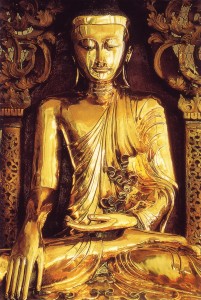 And it includes this image of a golden Buddha statue from the Shwedagon pagoda in Yangon, which I hope to be able to see in person…if the latest glitches in getting a VISA finally ever do get worked out.
And it includes this image of a golden Buddha statue from the Shwedagon pagoda in Yangon, which I hope to be able to see in person…if the latest glitches in getting a VISA finally ever do get worked out.
(Oh the joys of exotic travel.)
Let go.
Let go.
Let go.
Buried Treasure
 Now that I’m retired….I mean, now that I’m working full time on my self-directed, self-funded, multi-media, inner research project….I’ve been cleaning out my upstairs study to make room for the art books, post cards, tarot decks, maps, binders, notebooks, and all the other indispensable stuff I used to keep at my office, but now have to find a place for here.
Now that I’m retired….I mean, now that I’m working full time on my self-directed, self-funded, multi-media, inner research project….I’ve been cleaning out my upstairs study to make room for the art books, post cards, tarot decks, maps, binders, notebooks, and all the other indispensable stuff I used to keep at my office, but now have to find a place for here.
And I came across a sweet little book I didn’t know I had, called Teachings of the Buddha, edited by Jack Kornfield. Since I had nothing better to do (remember, I’m a full-time Inner Researcher now), I opened the book at random and read:
Just as water flowing in the streams and rivers fills the ocean, thus may all your moments of goodness touch and benefit all beings, those here and now and those gone before.
May all your wishes be soon fulfilled as completely as the moon on a full-moon night, as successfully as from the Wish-Fulfilling Gem. May all dangers be averted; may all disease leave you.
May no obstacles come across your way and may you enjoy happiness and long life.
May those who are always respectful, honoring the way of the elders, prosper in the four blessings of old age, beauty, happiness, and strength.
(adapted from the Pattanumodana blessings chant)
***
And now I offer this blessing to you.
May it be so.
